This wonderful Cornish workshop and museum is dedicated to the legacy of studio pottery trailblazer Bernard Leach
Become an instant expert on the temples of Angkor
Become an instant expert on the temples of Angkor
22 Jul 2022
This year marks 30 years since Angkor in Cambodia became a UNESCO World Heritage Site. Our expert, Denise Heywood, takes us on a tour of its extraordinary temples, which collectively make up one of the wonders of the world
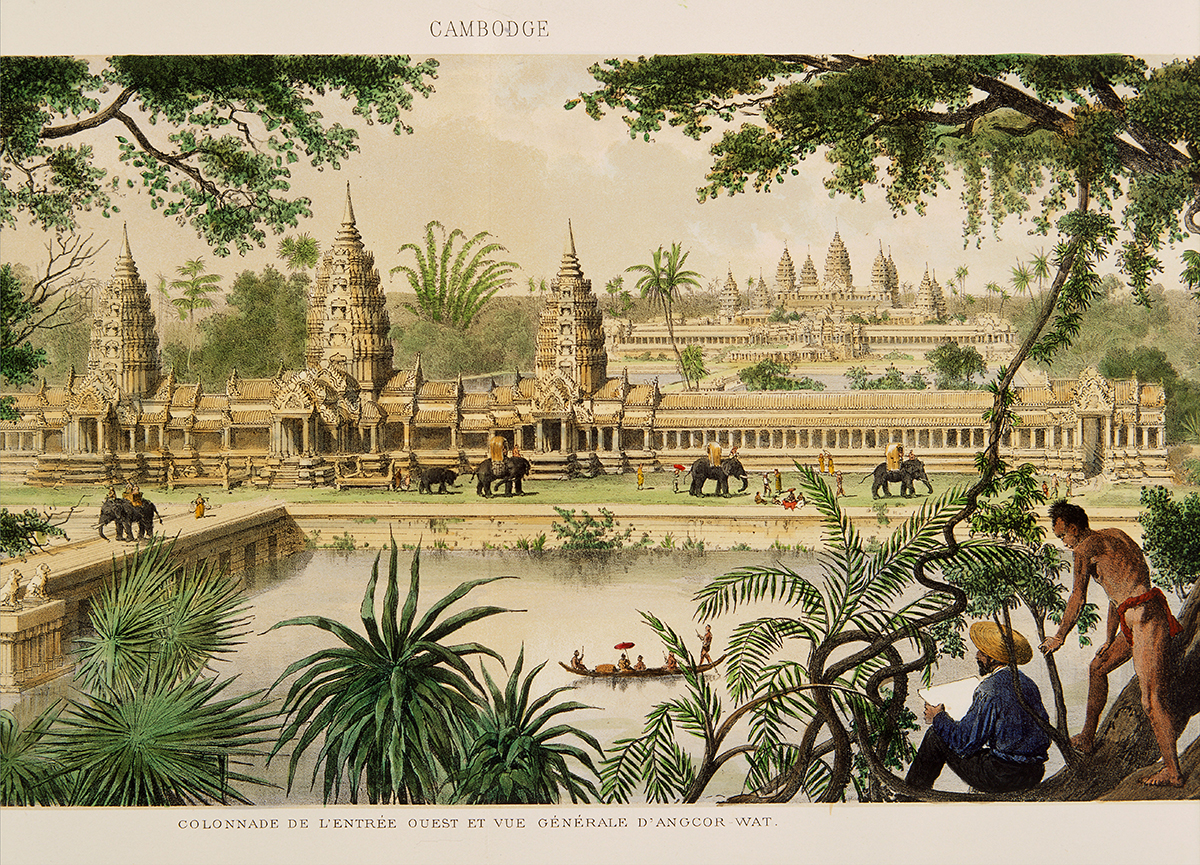 Angkor Wat, Cambodia
Angkor Wat, Cambodia
‘It is grander than anything left to us by Greece or Rome…’
Explorer Henri Mouhot in 1861, on first seeing Angkor Wat in Cambodia
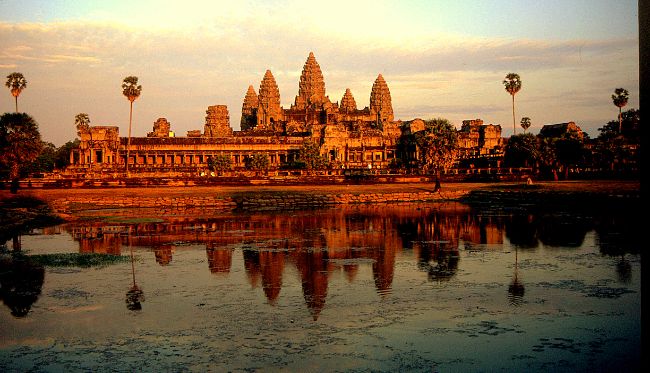 A view of Angkor Wat
A view of Angkor Wat
1. LOST IN THE JUNGLE
The sacred site of Angkor lay hidden in the jungle for over 500 years.
Once part of an empire that spanned Southeast Asia between the eighth and 15th centuries, it was almost lost to the world after the Cambodian kingdom fell into decline, and was abandoned in the 1400s, after the Siamese attacked and defeated Angkor.
The French explorer Henri Mouhot was one of the first Europeans to visit Angkor, while on a Royal Geographical Society-sponsored expedition in 1861. Enthralled by the romantic sight of ancient ruins emerging from tropical forest, he marvelled: ‘Suddenly, and as if by enchantment, [the traveller]… is transported from darkness to light.’ He declared it the ‘work of giants’.
Angkor means ‘holy city’ and Wat means ‘temple’. Angkor Wat is the main temple at Angkor and the biggest religious monument in the world, measuring more than one and a half square kilometres. It is the most magnificent of a dozen Hindu and Buddhist temples amid scores of ruins in an area of 400 square kilometres in northern Cambodia, formerly Kambuja, the kingdom of the Khmers (Cambodians). Its creation was influenced by India, from where maritime trade brought ideas, commerce and religion.
With its symmetry, harmony and sculpture, Angkor Wat is the apotheosis of Khmer art and is the most celebrated monument and main attraction for visitors, along with the temples of the Bayon, Ta Prohm and Banteay Srei.
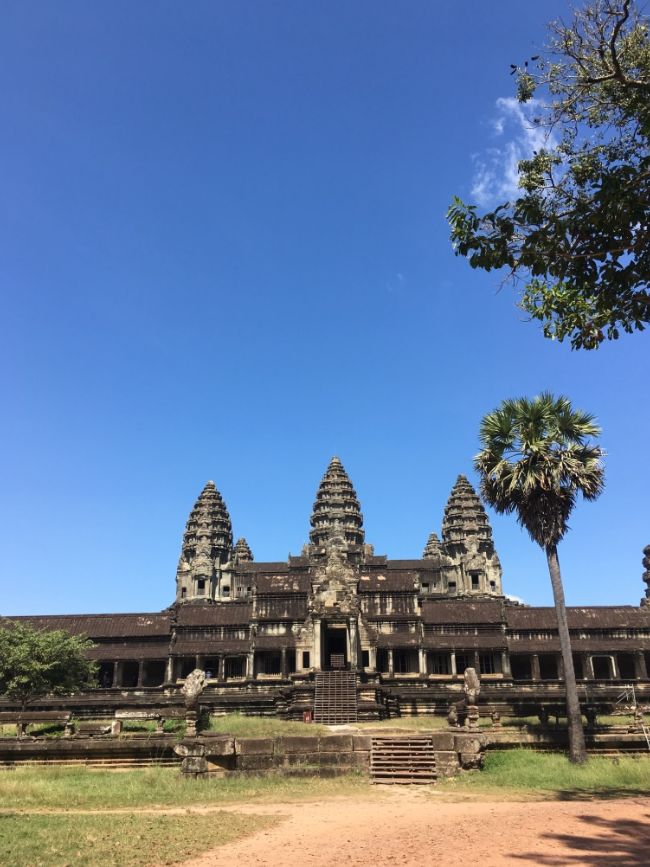 The south entrance of Angkor Wat temple
The south entrance of Angkor Wat temple
2. COSMOS ON A MOUNTAIN
Built between AD 1113 and 1150 under King Suryavarman, a religious but war-like ruler, Angkor Wat is a temple mountain.
It is a sandstone replica of the Hindu universe and an earthly representation of the cosmic world.
A quincunx of five towers shaped like lotus buds, the sacred flower of Hinduism, with the central one rising above the four others, form a dramatic pyramidal structure, its successive levels ascending in ever diminishing storeys from a base of richly carved courtyards and galleries. The towers symbolise the peaks of the mythical Mount Meru, the abode of the gods. The outer walls correspond to the edge of the world. The surrounding moat represents the cosmic ocean.
Dedicated to the Hindu god Vishnu, the temple was conceived by numerous architects during 37 years of construction and was built by 50,000 labourers. It was brilliantly designed by astronomers and astrologers to align with the sun, the moon and the stars, and was radiantly carved by gifted sculptors.
Mythological scenes from the Hindu religious epics the Mahābhārata and the Rāmāyana are depicted around it on the longest bas-relief in the world. Over 1,860 carved naked female figures adorn the walls. Are they goddesses – devatas? Or celestial dancers – apsaras?
Their role is uncertain, but their allure is indisputable. Sensuous but not erotic, they evoke youth, fertility, vitality and earthly pleasures. Their graceful poses are regarded as the origins of Cambodian dance, the rhythms of which symbolise the rhythms of the cosmos, of which the temple is a recreation on Earth. Within what is thought to be a funerary monument, they bring not only a vivid representation of life, but that of the life force itself.
Angkor Wat faces west, the only temple to do so, as all the others face east to the rising sun. It faces the setting sun and darkness, symbols of death, and is thought it could be a mausoleum for the king, perceived as a ‘god king’.
At dawn on the vernal equinox, the sun rises up behind the eastern entrance and exactly over the top of the central tower to create a spectacular solar alignment with the west end of the causeway.
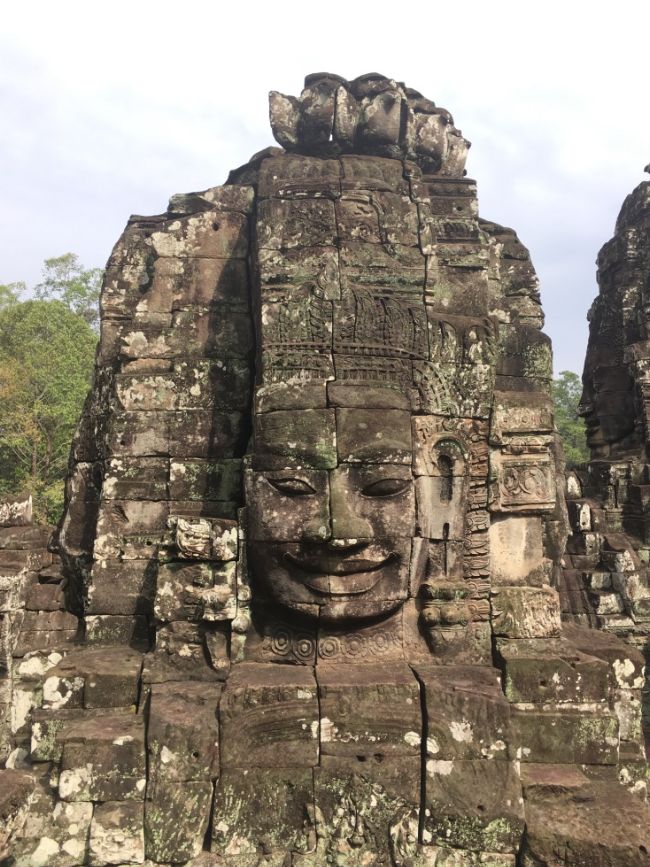 One of the serene giant carved faces on the Bayon
One of the serene giant carved faces on the Bayon
3. A TALE OF TWO TEMPLES
The kingdom’s prosperity came from trade, as its sophisticated hydraulic system, with canals and reservoirs that harnessed the waters of the central lake, the Tonlé Sap, enabled the sale of several rice harvests a year.
By 1180 a new capital, Angkor Thom, was built, featuring another majestic sanctuary.
The Bayon, a temple mountain surrounded by a moat, was constructed between 1180 and 1220 in grey sandstone on the orders of the last great king, Jayavarman VII, a devout Buddhist.
This dark, mysterious, grandiose edifice, enveloped in jungle when discovered and still so confusing one gets lost, is dominated by colossal, enigmatic towers, with a face carved onto each one. Thought to originally number 54, the identity of the faces is speculated to be Avalokiteshvara, the compassionate Buddha. The haunting visages, with eyes open or closed, peer down with strange half smiles. The temple’s many steep steps, hidden corridors and tenebrous courtyards heighten a sense of bewilderment and awe.
Carvings of dancers appear everywhere, perhaps for esoteric rituals. Uniquely, secular scenes also appear on the walls, showing the daily life of fishermen, fortune tellers, cooks preparing fish kebabs and women giving birth, as well as military processions for battles with neighbouring Siam and Champa. Embellished with birds, monkeys, trees and rural life, these offer a fascinating insight into how ordinary people lived here in the 12th century. Surprisingly, many aspects have not changed.
In similar dark sandstone, the 12th-century Ta Prohm, also built by Jayavarman VII, is a reminder of how Mouhot first saw the temples, swathed in jungle, imbued with a sense of lost time.
French conservators preserved it as such, instead of renovating it. Although it has had much restoration of late, it is nevertheless compelling for its innumerable overgrown trees that snake their way through galleries and courtyards, a vision of juxtaposed forces of nature and human achievements.
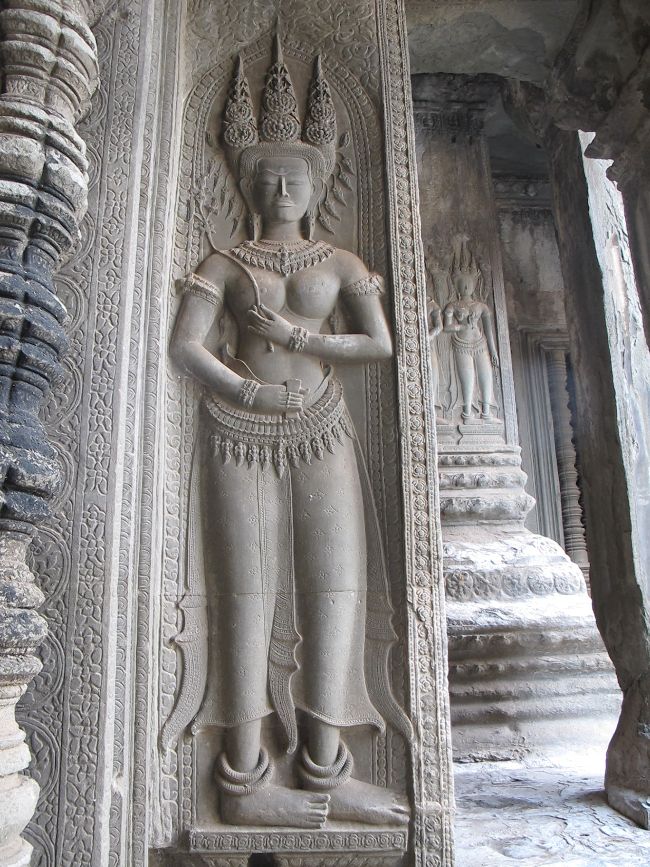 One of the devatas carved into a niche at Banteay Srei temple
One of the devatas carved into a niche at Banteay Srei temple
4. THE CHAPEL IN THE FOREST
Long before these ambitious regal projects, in the 10th century, a miniature chapel was built in the forest by a Hindu priest, a Brahmin, who employed the kingdom’s best sculptors.
The delicate pink sandstone Banteay Srei is the most refined, exquisitely carved of all the temples at Angkor.
It is also the smallest.
Known as the ‘jewel of Khmer art’, a ‘fairy tale’ temple, Banteay Srei, ‘citadel of the women’, is dedicated to the Hindu god Shiva. The ‘women’ are possibly the devatas in the central sanctuary who are of transcendent beauty.
Along the main causeway galleries and hallways lead to the central sanctuary, composed of three towers on a platform. Less than 10 metres high, they are perfectly proportioned and adorned with Hindu legends. Every surface is sculpted with foliage, flowers, garlands, scrolls, tapestry motifs and mythical beasts and birds, interspersed with wondrous deities.
The serene devatas ‘stand’ in their niches, their sensual figures, plaited hair, long earlobes, necks, wrists and hips draped in fabulously sculpted jewels. Their ethereal faces radiate a spiritual aura. Youthful male guardian deities (called dvarapalas) occupy other niches in contrapposto poses, enhancing the dynamism of their classically proportioned anatomy.
The details and sheer beauty of these figures are best seen as the sun rises and illuminates the pink sandstone, transforming its colour with startling clarity.
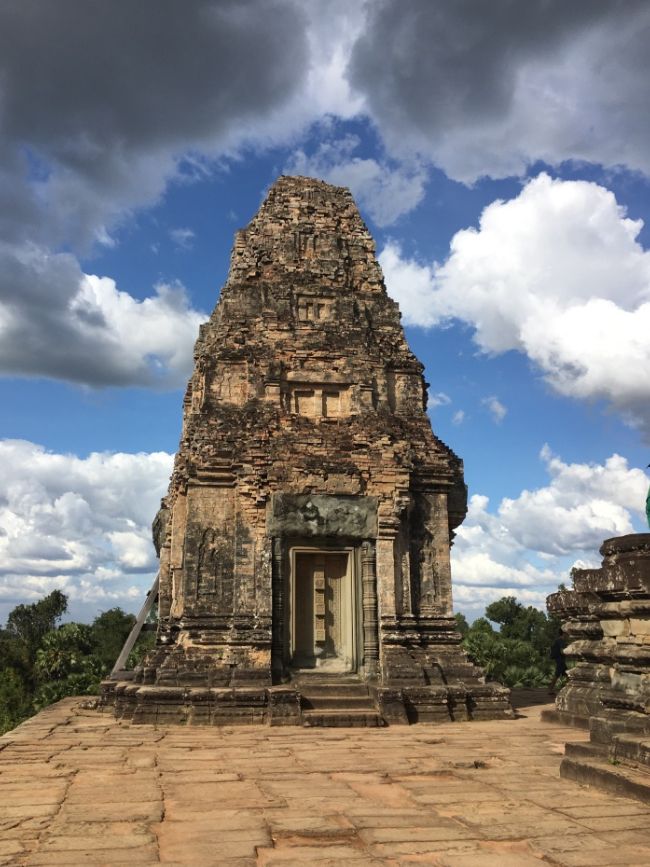 Detail of the temple of Pre Rup
Detail of the temple of Pre Rup
5. APOGEE, DECLINE, RECOVERY
Many other remarkable temples were built at Angkor, including the early Roluos Group, then later Preah Khan, Bakong, Baphoun, Banteay Samre, Takeo, Pre Rup and, further afield, Banteay Chhmar and Beng Mealea.
But ultimately, architectural brilliance and religious fervour were overshadowed by wars, overspending and possible climate change. Angkor was defeated by the Siamese in the 1400s and the last king fled. The immense site, apart from Angkor Wat, succumbed to the jungle and oblivion.
Although not the first visitor, Mouhot’s descriptions brought it to the attention of the West. Cambodia became part of France’s colonial regime in the 19th century, along with Vietnam and Laos. The site was restored and studied by dedicated French scholars. In the 20th century independence was followed by tragic wars. By the 1990s recovery began and, prior to the pandemic, Angkor became one of the most important tourist attractions in Asia. It is protected and managed by the APSARA National Authority.
In 1992 Angkor was inscribed as a UNESCO World Heritage Site, rated as one of the most important archaeological sites in Southeast Asia and the largest archaeological site in the world.
DENISE'S TOP TIPS
Visit
Covid-19 restrictions willing, Angkor is best visited between November and February, the dry season.
As Cambodia is such a long way to go, consider combining it with a visit to Laos as well. Spend at least three days at Angkor, but five days, or even a week, would be better, as there are so many temples to see. Visit Angkor Wat at least twice, at sunrise and at sunset, to admire the carvings. Visit Banteay Srei early morning to best appreciate its carvings. See a classical dance performance if you can, possibly at a good hotel, and a visit to silk weavers and silversmiths and to see local craftspeople at work is always worthwhile.
Closer to the UK, you can visit Paris and the Musée Guimet, with its magnificent collection of Khmer artefacts.
Good reads
- Angkor by Dawn Rooney, published by Odyssey Guides
- Art & Architecture of Cambodia by Helen Ibbitson Jessup, published by Thames & Hudson
- Focusing on the Angkor Temples: the guidebook by Michel Petrotchenko published by The Guidebook
Images of the Gods: Khmer Mythology in Cambodia, Thailand and Laos by Vittorio Roveda, published by River Books
IF YOU ENJOYED THIS INSTANT EXPERT EMAIL...
Why not forward this on to a friend who you think would enjoy it too?
About the Author
Denise Heywood
Denise Heywood is a writer, lecturer and photographer. In 1992 she went to Cambodia for a week and stayed for three years, captivated by Angkor. She has been a scholar of Southeast Asia ever since. Denise has lectured worldwide, written for many art, literary and travel publications, and appeared on radio and television. Her books include Ancient Luang Prabang & Laos, also in French, and Cambodian Dance: Celebration of the Gods. Based in London, she presents talks for leading art and academic institutions, and is visiting lecturer for SOAS University of London, The Courtauld Gallery, Victoria and Albert Museum and more. She has led art tours to Southeast Asia for the Royal Academy of Arts and has been the guest speaker on cruise ships. Among her other talks for The Arts Society are Laos: A Little Paradise; Vietnam: Ancient and Modern Artistic Heritage; Legend and Lustre: Jim Thompson and Thai Silk; Sir Stamford Raffles: Art Collector and Founder of Singapore; and Road to Bali: From Borobudur to Balinese Dance. For more, see deniseheywood.co.uk
Article Tags
JOIN OUR MAILING LIST
Become an instant expert!
Find out more about the arts by becoming a Supporter of The Arts Society.
For just £20 a year you will receive invitations to exclusive member events and courses, special offers and concessions, our regular newsletter and our beautiful arts magazine, full of news, views, events and artist profiles.
FIND YOUR NEAREST SOCIETY
MORE FEATURES
Ever wanted to write a crime novel? As Britain’s annual crime writing festival opens, we uncover some top leads
It’s just 10 days until the Summer Olympic Games open in Paris. To mark the moment, Simon Inglis reveals how art and design play a key part in this, the world’s most spectacular multi-sport competition



